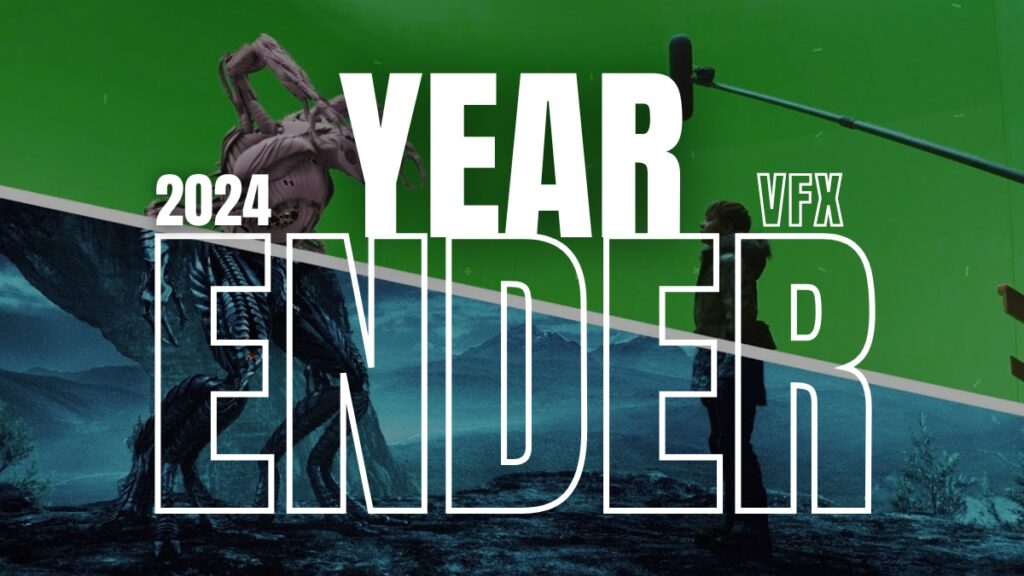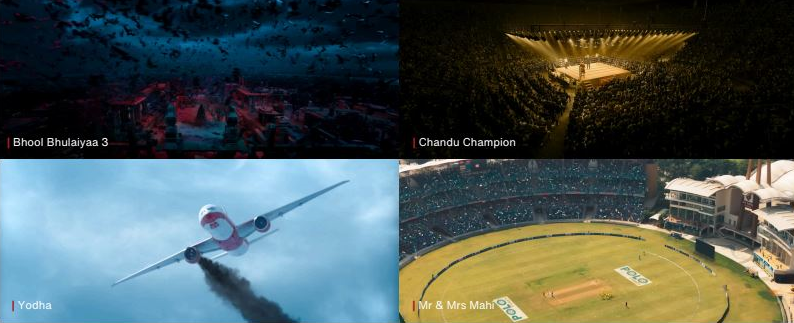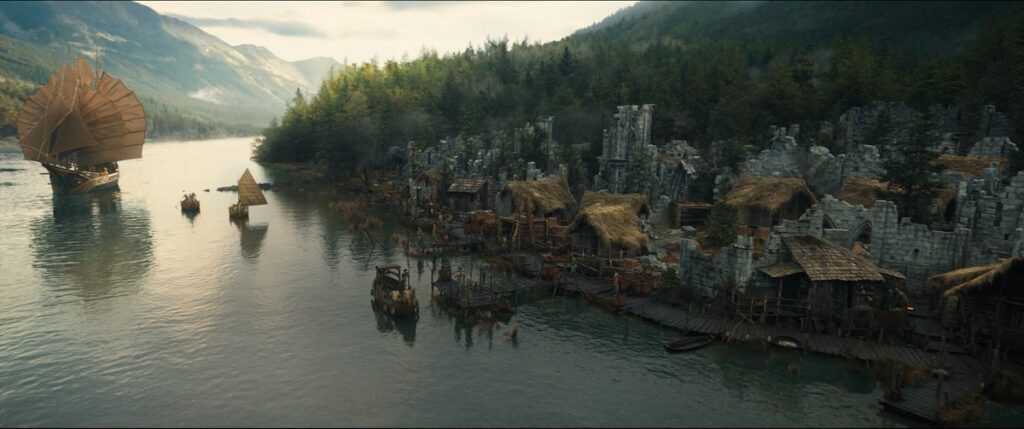Recovering from the aftermath of global challenges like the writer’s strike, the visual effects (VFX) industry in India maintained slow but steady momentum, churning out on-screen marvels like Kalki 2898 AD, Bhool Bhulaiyaa 3, Pushpa 2:The Rule and more. The sector witnessed major collaborations reflecting its long term potential growth. However, the industry insiders felt that they are yet to completely return to the normal track and venture ahead.
Two major reasons for the WGA and SAG-AFTRA to go on strike were: the prevalence of streaming services and the challenge posed by AI, affecting the entertainment industry at large. Incidentally, the year 2024 majorly witnessed the VFX industry’s focus on adapting the technological innovations which included experimentation with AI in their pipeline. This year was about exploring and integrating emerging technologies, particularly advancements in AI.
As we ease into 2025, we look at the trends and developments in 2024 and how some of the leading Indian studios fared in terms of projects, business and more.
Major projects, milestones and the progress report
In 2024, PhantomFX played a pivotal role in several major projects, including Pushpa 2, Indian 2, IC814, Devara, Citadel: Honey Bunny, and many other international and domestic productions. Across these projects, the studio delivered over 7000 VFX shots, contributing substantially to the visual storytelling of each film. From creating digital doubles, realistic creature animation, and fluid simulations to high-end motion tracking, the studio has contributed substantially to these projects.
Redchillies.vfx (RCVFX) worked on over 6000 VFX shots across illustrious projects like Bhool Bhulaiyaa 3, Chandu Champion, Yodha and many more. Most significantly, the studio delved into AI by making the first all AI-based short film Dasavatar, which was directed by Atlee (Jawan) and presented at Nita Mukesh Ambani Cultural Centre.
For UK-based Outpost VFX, known for its work in The Wheel of Time, major highlights of this year included delivering significant work for The Lord of the Rings: The Rings of Power season 2, Wicked, Silo season 2, Bridgerton season 3, Madame Web and so on.
According to Outpost VFX India creative operations Rutvij Barot, what can be considered a normal amount of activity in the market has not yet re-emerged in the period since the joint WGA/SAG strike action in 2023. “That said, we can see green shoots of more consistent production volumes in the first part of 2025. Although we’ve been a bit quieter than we would’ve liked to be, we’ve done well to secure work on some of the larger projects that have made it through production.”
Talking about some of last year’s major highlights, Technicolor Group Asia Pacific global executive committee member managing director Biren Ghose shared about their Corporate Social Responsibility (CSR) initiatives in India.
Technicolor Group made significant strides with new projects and some of them had the involvement of their Indian counterparts. Disney’s Mufasa: The Lion King and Emilia Pérez, both from MPC were shortlisted for the Academy Awards. Emilia Pérez also won four recent Golden Globe awards. The Mill delivered Life Song’s French version making a strong case for social change premiered at the UNESCO HQ and Ricky Kej’s rendition of the Indian National Anthem for the Indian Independence Day screened in theatres nationwide.
Mikros Animation contributed to global animated films like Thelma the Unicorn, Orion and The Dark, Ozi, Voice of the Forest, among the others, while Technicolor Games expanded its reach with titles such as EA Sports FC25 and Dragon Age: The Veilguard.
DNEG and ReDefine had jointly worked on over 900 shots for the film, with a large team of over 1200 artists from both studios creating some of the crucial visual moments of blockbuster Kalki 2898 AD. Also, 3,500 plus VFX shots were created by a global crew of over 2,600 individuals, including over 80 artists from ReDefine India’s FX team who were specifically dedicated to Hrithik Roshan and Deepika Padukone-starrer Fighter.
Collaborations and mergers
Phantom Digital Effects acquired a majority stake of 80 per cent in Tippett Studio, known for creating marvels like Jurassic Park, and Starship Troopers. This acquisition is expected to result in a significant increase in revenue growth of 20-25 per cent during the 2024-25 financial year. Tippett has several upcoming projects with leading Hollywood production houses and studios. This acquisition may lead to the addition of 250 to 300 employees in India, the United States and Canada for PhantomFX, which will further enhance its global footprint and capabilities.
“We began establishing a presence in the Chinese market, unlocking opportunities for collaboration and growth,” shared PhantomFX founder and CEO Bejoy Arputharaj.
For the Chennai-headquartered Basilic Fly Studio (BFS), 2024 was marked by two major developments: acquisition of a 70 per cent stake in London’s VFX studio One of Us, and getting its IPO listed on the NSE (National Stock Exchange of India). Together with One of Us, BFS has bolstered its capacity to over 900 artists. BFS has been part of iconic projects including Avatar, Avengers: Endgame, and The Last of Us.
The DNEG Group completed its acquisition of Prime Focus Technologies (PFT), a creator of AI-powered technology solutions for the M&E industry in 2024. Also, UAE’s United Al Saqer Group (UASG) invested US$200 million in the VFX and animation major.
Technologies that dominated 2024
UASG’s investment in the DNEG Group will support the activation of a new technology division, Brahma, which is developing a comprehensive AI-powered, photo-real CGI creator. Their investment will help in the opening of a new visual experience hub in Abu Dhabi, with plans to develop an ecosystem for content production, storage and distribution in the region.
According to Arputharaj, AI and Universal Scene Description (USD) will continue to dominate discussions in 2025 as well. Many professionals have already begun integrating open-source AI tools into their workflows. Similarly, most studios are actively upgrading their pipelines to leverage USD, which enables more flexible, parallel workflows and facilitates seamless file sharing between studios.
“We have been leveraging AI for automation and generation. We utilise generative AI to create concepts and swiftly convert them into videos for pitch decks. Additionally, we employ AI for de-aging and head replacement shots in compositing. We are developing a completely new pipeline tool to standardise our workflows across multiple departments. Additionally, we are working on a USD-based render-agnostic pipeline, which enhances our flexibility and prevents us from being tied to any specific software,” said Arputharaj.
For Outpost VFX, the main focus in 2024 was to continue developing their technology stack and pipeline, as well as looking at emerging tools. “All of our studios globally operate on the same unified virtual cloud platform within AWS and leveraging that alongside rolling out a whole new VFX pipeline has been a big focus for our tech team,” added Barot.
He seconded the fact that at the moment everyone is looking at the developments in AI and machine learning in 2025, and what that means in a visual effects context. Their team has been developing and releasing a new pipeline globally, which has been a significant undertaking. “The ultimate aim of this has been to broaden our technical capabilities and allow us to be as agile as possible going forward. We want to be able to adapt quickly to developments in tech and the new pipeline allows us to do just that,” he revealed.
Ghose pointed out, “AI-assisted animation and XR (extended reality) saw significant growth, enhancing creative experiences and offering new possibilities. Moving into 2025, AI-driven animation, AR/VR experiences, and AI for virtual production are expected to continue evolving, shaping the future of animation and VFX with even more immersive and innovative applications.”
According to RCVFX, AI is still being explored, but shows great promise in assisting the VFX pipeline by automating repetitive tasks and streamlining workflows. “Our team ended up using AI for delivering a project in two weeks, which otherwise would have taken three months to complete using just conventional VFX. Unreal Engine, on the other hand, has become a powerful tool for realtime workflows, environment creation, and previsualisation, allowing studios to reduce turnaround times and enhance creativity,” said an RCVFX representative.
Trends observed in 2024
Arputharaj noted that the VFX industry is undergoing a profound transformation, driven by advancements in real-time rendering, AI, and virtual production. “These innovations are not just enhancing workflows but redefining the creative process itself, enabling unprecedented levels of precision and efficiency. We have seen a strong emphasis on sustainable practices and diverse narratives, setting new benchmarks for the industry. Finally, the focus sharpens on harnessing these technologies to deliver immersive, boundary-pushing experiences that elevate the art of visual storytelling.”
Ghose highlighted that real-time production technologies like Unreal Engine and Unity were at the forefront of the VFX and animation industries, enabling faster and more efficient workflows, especially for live-action and virtual productions.
Challenges and opportunities
Elaborating on the major challenges in terms of the overall market, Barot shared, “Our challenges were similar to any other studio that services the US market – a reduction in production volumes during and after the strikes. Our team had to sacrifice a lot, and there’s been a lot of uncertainty industry wide. All we’ve been able to do is continue to focus on delivering excellent creative work to the highest standard we can, and remain communicative with our clients and our team.”
PhantomFX faced several challenges, including rapid technological advancements, and the evolving demands of the market. One of the major hurdles was adapting to new technologies, particularly AI, and finding innovative ways to incorporate these advancements into their post-production processes while meeting client expectations. “We focused on securing as much work as possible and streamlining our operations by developing automation tools to reduce manual effort and optimise workflows. While domestic projects often come with tight budgets and timelines, we embraced these challenges as opportunities to push the boundaries of creativity and efficiency.”
By focusing on diverse projects, PhantomFX ensured that the team remains engaged, inspired, and ready to tackle the evolving demands of the industry. “Our focus on innovation has led to the development of advanced automation tools and streamlined workflows, enabling us to deliver exceptional results with agility.”
For RCVFX, working with AI in the pipeline was a learning curve. It was a challenge, but one that they learned from. “I think we can see movie-makers utilising VFX more and more to bring their visions to life. The next five years will have some amazing stories being told using visual effects as a driving medium,” said the RCVFX representative.
Plans and projects for 2025
The Indian VFX leaders observed that as the industry continues to evolve, quality of work continues to increase. Everyone who belongs to this industry has shown an incredible amount of resilience and patience during a difficult period for VFX.
“Our clients and our own research point to a hopefully more stable start to 2025 and an increase in shoots from the new year, so we feel there’s much to be positive about next year,” Barot shared.
PhantomFX is planning a major global expansion, aiming to reach new markets and opportunities. “Our focus will be on aligning our vision with an ever-growing scope, pushing boundaries in creativity and innovation. Exciting times lie ahead as we embark on this journey,” added Arputharaj.
RCVFX is currently working on the director debut web-series of Aryan Khan for Netflix, as well as Salman Khan’s much awaited upcoming movie Sikandar. Additionally, there are multiple other big projects they have been working on for 2025, which will be disclosed post the official announcement.
Currently, Technicolor is involved in several high-profile projects including Under Paris, Michelin On the Road and Beyond, and The Mill’s work on Pepsi’s Mini Holiday Baking Show featuring Shaq. Technicolor also contributed to Vikings: Valhalla (Season 3), Star Trek: Prodigy (Season 2), and The Serpent Queen (Season 2).
The company is set to continue expanding its capabilities across VFX, animation, gaming, advertising, experiential entertainment, and immersive experiences, with a particular focus on real-time production, AI-driven animation, and AR/VR technologies. Additionally, the company plans to integrate eco-friendly practices and set ambitious goals for reducing its environmental impact.
Most of the above-mentioned studios and other big names in the Indian VFX industry, look forward to growing as a team, taking on more projects, scaling up operations, and continuing to push creative boundaries. Ultimately, their goal remains to ensure that the hard work they put into their projects is appreciated, resonating with audiences and earning recognition within the industry.




